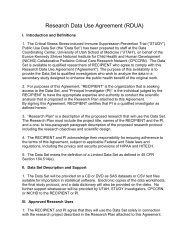CDC Definitions of Nosocomial Infections (PDF) - CPCCRN
CDC Definitions of Nosocomial Infections (PDF) - CPCCRN
CDC Definitions of Nosocomial Infections (PDF) - CPCCRN
Create successful ePaper yourself
Turn your PDF publications into a flip-book with our unique Google optimized e-Paper software.
Chapter 94: Surveillance <strong>of</strong> <strong>Nosocomial</strong> <strong>Infections</strong> 1685COMMENT:Breast abscesses occur most frequently after childbirth. Thosethat occur within 7 days after childbirth should be considerednosocomial.INFECTION SITE: OmphalitisCODE: SST-UMBDEFINITION: Omphalitis in a newborn (30 days old) mustmeet at least one <strong>of</strong> the following criteria:Criterion 1: Patient has erythema and/or serous drainage fromumbilicusandat least one <strong>of</strong> the following:a. Organisms cultured from drainage or needleaspirateb. Organisms cultured from blood.Criterion 2: Patient has both erythema and purulence at theumbilicus.REPORTING INSTRUCTIONS:Report infection <strong>of</strong> the umbilical artery or vein related toumbilical catheterization as CVS-VASC if blood culture isnegative or not done.Report as nosocomial if infection occurs in a newborn within7 days <strong>of</strong> hospital discharge.INFECTION SITE: Infant pustulosisCODE: SST-PUSTDEFINITION: Pustulosis in an infant (12 months old) mustmeet at least one <strong>of</strong> the following criteria:Criterion 1: Infant has one or more pustulesandphysician diagnosis <strong>of</strong> skin infection.Criterion 2: Infant has one or more pustulesandphysician institutes appropriate antimicrobialtherapy.REPORTING INSTRUCTIONS:Do not report erythema toxicum and noninfectious causes <strong>of</strong>pustulosis.Report as nosocomial if pustulosis occurs in an infant within7 days <strong>of</strong> hospital discharge.INFECTION SITE: Newborn circumcisionCODE: SST-CIRCDEFINITION: Circumcision infection in a newborn (30 daysold) must meet at least one <strong>of</strong> the following criteria:Criterion 1: Newborn has purulent drainage from circumcisionsite.Criterion 2: Newborn has at least one <strong>of</strong> the following signsor symptoms with no other recognized cause atcircumcision site: erythema, swelling, or tendernessandpathogen cultured from circumcision site.Criterion 3: Newborn has at least one <strong>of</strong> the following signsor symptoms with no other recognized cause atcircumcision site: erythema, swelling, or tendernessandskin contaminant (coagulase-negative staphylococci,diphtheroids, Bacillus sp., or micrococci) iscultured from circumcision siteandphysician diagnosis <strong>of</strong> infection or physician institutesappropriate therapy.REPORTING INSTRUCTION:Newborn circumcision is not an NNIS operative procedure;do not report as an SSI.INFECTION SITE: Disseminated infectionCODE: SYS-DIDEFINITION: Disseminated infection is infection involvingmultiple organs or systems, without an apparent single site <strong>of</strong>infection, usually <strong>of</strong> viral origin, and with signs or symptomswith no other recognized cause and compatible with infectiousinvolvement <strong>of</strong> multiple organs or systems.REPORTING INSTRUCTIONS:This code should be used primarily for viral infections involvingmultiple organ systems (e.g., measles, mumps, rubella,varicella, erythema infectiosum). These infections <strong>of</strong>ten canbe identified by clinical criteria alone. Do not use this codefor nosocomial infections with multiple metastatic sites, suchas with bacterial endocarditis; only the primary site <strong>of</strong> theseinfections should be reported.Do not report fever <strong>of</strong> unknown origin (FUO) as DI-SYS.Report neonatal ‘‘sepsis’’ as BSI-CSEP.Report viral exanthems or rash illness as DI-SYS.APPENDIX A-2. CRITERIA FOR DEFININGNOSOCOMIAL PNEUMONIAGeneral Comments Applicable to AllPneumonia Specific Site Criteria1. Physician’s diagnosis <strong>of</strong> pneumonia alone is not an acceptablecriterion for nosocomial pneumonia.2. Although specific criteria are included for infants and children,pediatric patients may meet any <strong>of</strong> the other pneumoniaspecific site criteria.3. Ventilator-associated pneumonia (i.e., pneumonia in personswho had a device to assist or control respiration continuouslythrough a tracheostomy or by endotracheal intubation withinthe 48-hour period before the onset <strong>of</strong> infection) should beso designated when reporting pneumonia data.4. When assessing a patient for presence <strong>of</strong> pneumonia, it isimportant to distinguish between changes in clinical statusresulting from other conditions such as myocardial infarction,pulmonary embolism, respiratory distress syndrome, atelectasis,malignancy, chronic obstructive pulmonary disease,hyaline membrane disease, bronchopulmonary dysplasia, andso forth. Also, care must be taken when assessing intubatedpatients to distinguish between tracheal colonization, upper



